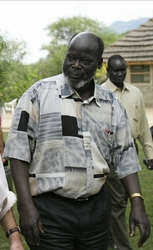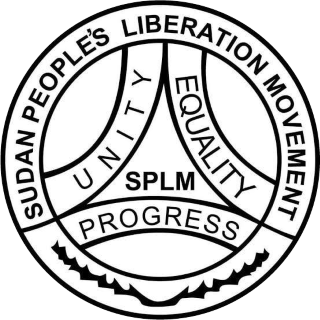Related Research Articles

Equatoria is the southernmost region of South Sudan, along the upper reaches of the White Nile and the border between South Sudan and Uganda. Juba, the national capital and the largest city in South Sudan, is located in Equatoria. Originally a province of Anglo-Egyptian Sudan, it also contained most of northern parts of present-day Uganda, including Lake Albert and West Nile. It was an idealistic effort to create a model state in the interior of Africa that never consisted of more than a handful of adventurers and soldiers in isolated outposts.

The Second Sudanese Civil War was a conflict from 1983 to 2005 between the central Sudanese government and the Sudan People's Liberation Army. It was largely a continuation of the First Sudanese Civil War of 1955 to 1972. Although it originated in southern Sudan, the civil war spread to the Nuba mountains and the Blue Nile. It lasted for almost 22 years and is one of the longest civil wars on record. The war resulted in the independence of South Sudan 6 years after the war ended.

Dr. John Garang de Mabior was a Sudanese politician and revolutionary leader. From 1983 to 2005, he led the Sudan People's Liberation Army (SPLA) during the Second Sudanese Civil War. He briefly served as First Vice President of Sudan for three weeks, from the comprehensive peace agreement of 2005 until his death in a helicopter crash on July 30, 2005. A developmental economist by profession, Garang was a major influence on the movement that led to the foundation of South Sudan.

The Sudan People's Liberation Movement is a political party in South Sudan. It was initially founded as the political wing of the Sudan People's Liberation Army in 1983. On January 9, 2005 the SPLA, the SPLM and the Government of Sudan signed the Comprehensive Peace Agreement, ending the civil war. SPLM then obtained representation in the Government of Sudan, and was the main constituent of the Government of the then semi-autonomous Southern Sudan. When South Sudan became a sovereign state on 9 July 2011, SPLM became the ruling party of the new republic. SPLM branches in Sudan separated themselves from SPLM, forming the Sudan People's Liberation Movement–North. Further factionalism appeared as a result of the 2013–2014 South Sudanese Civil War, with President Salva Kiir leading the SPLM-Juba and former Vice President Riek Machar leading the Sudan People's Liberation Movement-in-Opposition.
Dr.Lam Akol Ajawin, is a South Sudanese politician of Shilluk descent. He is the current leader of National Democratic Movement (NDM) party. He is a former high-ranking official in the Sudan People's Liberation Army (SPLA), and subsequently became the Foreign Minister of Sudan from September 2005 to October 2007, when the Khartoum government offered the SPLA several other key ministries as part of a peace agreement.
The Thuri, also known as Shatt, and Luo people of South Sudan. They speak DheThuri, a Luo language that is similar to the Jur and Dinka languages. Having been perceived as close to the Dinka people, the Thuri were targets of ethnic violence during the Second Sudanese Civil War, when the "Army of Peace", a mostly Fertit pro-government militia, attacked them as supporters of the mostly Dinka SPLA rebels. This caused many Thuri to take up arms and to join the SPLA in order to take revenge against other Fertit groups.

The SPLA-Nasir was a splinter faction of the Sudan People's Liberation Army (SPLA), a rebel group that fought in the Second Sudanese Civil War. Originally created as an attempt by the Nuer tribe to replace SPLA leader John Garang in August 1991, it gradually became coopted by the government. The break away of Riek Machar from SPLM/A resulted in Nuer ethnic group massacring Garang's ethnic Dinka from Bor in the Bor massacre in 1991. This split resulted in the 1994 National Convention of New Sudan in Chukudum.
Paride Taban was a South Sudanese prelate of the Catholic Church and was the first leader of the Sudan Council of Churches, which was founded in February 1990. He was Auxiliary Bishop of Juba from 28 January 1980 to 2 July 1983 and served as Bishop of Torit from 1983 to 2004.
Daniel Koat Mathews is a Sudanese politician and Nuer leader, who has been effectively involved in the national politics for many years. He is now a major general in the Sudan People's Liberation Army.
William Nyuon Bany Machar He was a Southern Sudanese politician who was also one of the founders of the Sudan People's Liberation Army (SPLA). He was appointed third in command after John Garang and Kerubino Kuanyin Bol. While he worked as a commander of the SPLA he lived in Itang, a small Ethiopian town in the Gambela Region.

The flag of South Sudan was adopted following the signing of the Comprehensive Peace Agreement that ended the Second Sudanese Civil War. A similar version of the flag was previously used as the flag of the Sudan People's Liberation Movement. The flag of South Sudan predates the country, as the flag was adopted in 2005, while the country became independent in 2011.

The South Sudan People's Defence Forces (SSPDF), formerly the Sudan People's Liberation Army (SPLA), is the army of the Republic of South Sudan. The SPLA was founded as a guerrilla movement against the government of Sudan in 1983 and was a key participant of the Second Sudanese Civil War, led by John Garang. After Garang's death in 2005, Salva Kiir was named the SPLA's new Commander-in-Chief. As of 2010, the SPLA was divided into divisions of 10,000–14,000 soldiers.

Southern Sudan was an autonomous region consisting of the ten southern states of Sudan between its formation in July 2005 and independence as the Republic of South Sudan in July 2011. The autonomous government was initially established in Rumbek and later moved to Juba. It was bordered by Ethiopia to the east; Kenya, Uganda, and the Democratic Republic of the Congo to the south; and the Central African Republic to the west. To the north lies the predominantly Arab and Muslim region directly under the control of the central government. The region's autonomous status was a condition of a peace agreement between the Sudan People's Liberation Army/Movement (SPLA/M) and the Government of Sudan represented by the National Congress Party ending the Second Sudanese Civil War. The conflict was Africa's longest running civil war.
Kerubino Kuanyin Bol was a Sudanese rebel leader who was one of the founders of the Sudan People's Liberation Movement (SPLM) and one of the leaders of the Sudan People's Liberation Army (SPLA) during the Second Sudanese Civil War and was said to have fired the first shot in the conflict.
Joseph Oduho Haworu was a leading politician from southern Sudan who was active in the struggle for independence and a founding member of the Sudan People's Liberation Movement (SPLM).

James Wani Igga is a South Sudanese who was the second vice president of South Sudan. He was speaker of the National Legislative Assembly from 2011 to 2013 and secretary general of the Sudan People's Liberation Movement.

Dr. Lawrence Lual Lual Akuei was a Sudanese politician born in Mathiang-Agor village of Ajak area into a family of spiritual leader Lual Akuei Lual of Pakuein Paan-Deng sub-clan of Agaal-Liil section.
The Relief Association of Southern Sudan was a humanitarian organization in Sudan, operating during the Second Sudanese Civil War. It was the humanitarian wing of the forces of Riek Machar 1991-2003. SPLA-Nasir set up RASS to function as a local civilian authority, and for liaisons with United Nations agencies and NGOs. As of 1999, Simon Kun served as executive director of RASS.
Operation Thunderbolt was the codename for a military offensive by the South Sudanese SPLA rebel group and its allies during the Second Sudanese Civil War. The operation aimed at conquering several towns in Western and Central Equatoria, most importantly Yei, which served as strongholds for the Sudanese Armed Forces (SAF) and helped the Sudanese government to supply its allies, the Ugandan insurgents of the WNBF and UNRF (II) based in Zaire. These pro-Sudanese forces were defeated and driven from Zaire by the SPLA and its allies, namely Uganda and the AFDL, in course of the First Congo War, thus allowing the SPLA launch Operation Thunderbolt from the Zairian side of the border. Covertly supported by expeditionary forces from Uganda, Ethiopia, and Eritrea, the SPLA's offensive was a major success, with several SAF garrison towns falling to the South Sudanese rebels in a matter of days. Yei was encircled and put under siege on 11 March 1997. At the same time, a large group of WNBF fighters as well as SAF, FAZ, and ex-Rwandan Armed Forces soldiers was trying to escape from Zaire to Yei. The column was ambushed and destroyed by the SPLA, allowing it to capture Yei shortly afterward. Following this victory, the South Sudanese rebels continued their offensive until late April, capturing several other towns in Equatoria and preparing further anti-government campaigns.
The War of the Peters was a conflict primarily fought between the forces of Peter Par Jiek and Peter Gadet from June 2000 to August 2001 in Unity State, Sudan. Though both were leaders of local branches of larger rebel groups that were involved in the Second Sudanese Civil War, the confrontation between the two commanders was essentially a private war. As Par and Gadet battled each other, the Sudanese government exploited the inter-rebel conflict as part of a divide and rule strategy, aimed at weakening the rebellion at large and allowing for the extraction of valuable oil in Unity State. In the end, Gadet and Par reconciled when their respective superiors agreed to merge the SPDF and SPLA.
References
- 1 2 3 Yongo-Bure, Benaiah. Economic Development of Southern Sudan . Lanham, Md. [u.a.]: Univ. Press of America, 2007. pp. 197-198
- ↑ Rolandsen, Øystein H. Guerrilla Government: Political Changes in the Southern Sudan During the 1990s . Uppsala: Nordiska Afrikainstitutet, 2005. p. 81
- 1 2 Rolandsen, Øystein H. Guerrilla Government: Political Changes in the Southern Sudan During the 1990s . Uppsala: Nordiska Afrikainstitutet, 2005. pp. 108-110
- 1 2 Guarak, Mawut Achiecque Mach. Integration and Fragmentation of the Sudan: An African Renaissance . Bloomington, IN: AuthorHouse, 2011. p. 383
- 1 2 Rolandsen, Øystein H. Guerrilla Government: Political Changes in the Southern Sudan During the 1990s . Uppsala: Nordiska Afrikainstitutet, 2005. p. 83
- ↑ Rolandsen, Øystein H. Guerrilla Government: Political Changes in the Southern Sudan During the 1990s . Uppsala: Nordiska Afrikainstitutet, 2005. p. 84
- ↑ Sudan democratic gazette, ed. 56–67 . 1995. p. 144
- ↑ Rolandsen, Øystein H. Guerrilla Government: Political Changes in the Southern Sudan During the 1990s . Uppsala: Nordiska Afrikainstitutet, 2005. p. 116